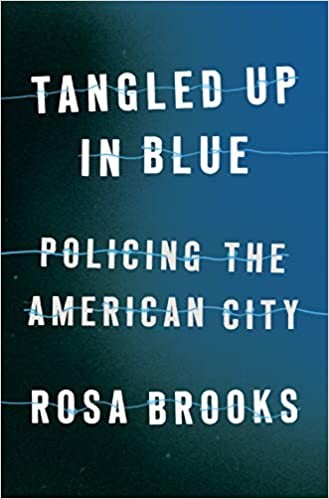
Rosa Brooks, Tangled Up in Blue: Policing the American City. New York: Penguin Press, 2021.
While Tangled Up in Blue is not an academic work, author Rosa Brooks explains that her use of participant observation is a valid research methodology that provides a close-up perspective on urban policing. Brooks learned this methodology firsthand. She’s the daughter of Barbara Ehrenreich of Nickel and Dimed fame. While Brooks dedicates the book to her political activist mother, she also cites the mother-daughter conflicts that accompanied Brooks’ transition from Georgetown law professor to part-time reserve officer with the Washington, D.C. Metropolitan Police Department (MPD). Written after the George Floyd killing, Brooks’ book gives a personalized account of her own messy, complicated experiences that come from patrolling the very poorest sections of D.C. As for the books’ title, “Tangled Up in Blue” comes from a Bob Dylan song released in 1975.
Brooks graduated from the police academy as a reserve officer in 2016. She highlights this experience by stating that “The chief lesson learned at the academy was this: Anyone can kill you at any time.” (p.79) She further describes the academy as a place where students had a great deal and even obsessive exposure to dangerous scenarios through instructional videos and lectures as well as physical training in defensive tactics. Brooks, who reports that the academy taught the thousands of ways that cops could be hurt or killed, leaves the reader with the impression that police training creates a cadre of hypersensitized, new officers who are hypervigilant about letting their guard down.
In the section of the book titled “The Street,” Brooks describes the wide variety of situations she’s encountered as a new reserve patrol officer in the 7th District MPD. This impoverished area of the city breeds domestic abuse and family disturbances, assaults, missing children, and mental and medical health related issues. Brooks offers her personal stories of life as a patrol officer and the individuals she’s connected with—her text gives a firsthand view of their “unvarnished lives.” She sees into their humanity as “angry people, weeping people, frightened and hurt people.” (p.255) It’s in this section of the book that the reader gets the most insight into the world of policing in D.C.
In the chapter “Baked Into the System,” Brooks addresses the criminal justice system and the racial disparities that stem from poverty as well as race. The author states that “this is why racism seems like a nonissue to many street cops; it’s baked so deeply into the system that it’s invisible.” (p. 272) When she attempts to offer an academic and sociological perspective to her police colleagues, she initiates a clash of two worlds when they react to her insights with disinterest or derision.
As for Brooks’ earlier description of life in the academy and its obsession with survival, she later struggles with this concept after months of actively working the streets of D.C. She confides, in contrast to her expectations from her training, that she found policing not to be that violent. Brooks concludes with a question: “What if instead of telling officers they have a right to go home safe, police training focused instead on reminding officers that members of the public have a right to go home safe?” (p 319)
With regard to policing, Rosa Brooks offers an inside view that is palpable and informative. Her book represents a well-rounded effort at immersive journalism. The book is available for loan from the Ramsey County Law Library.